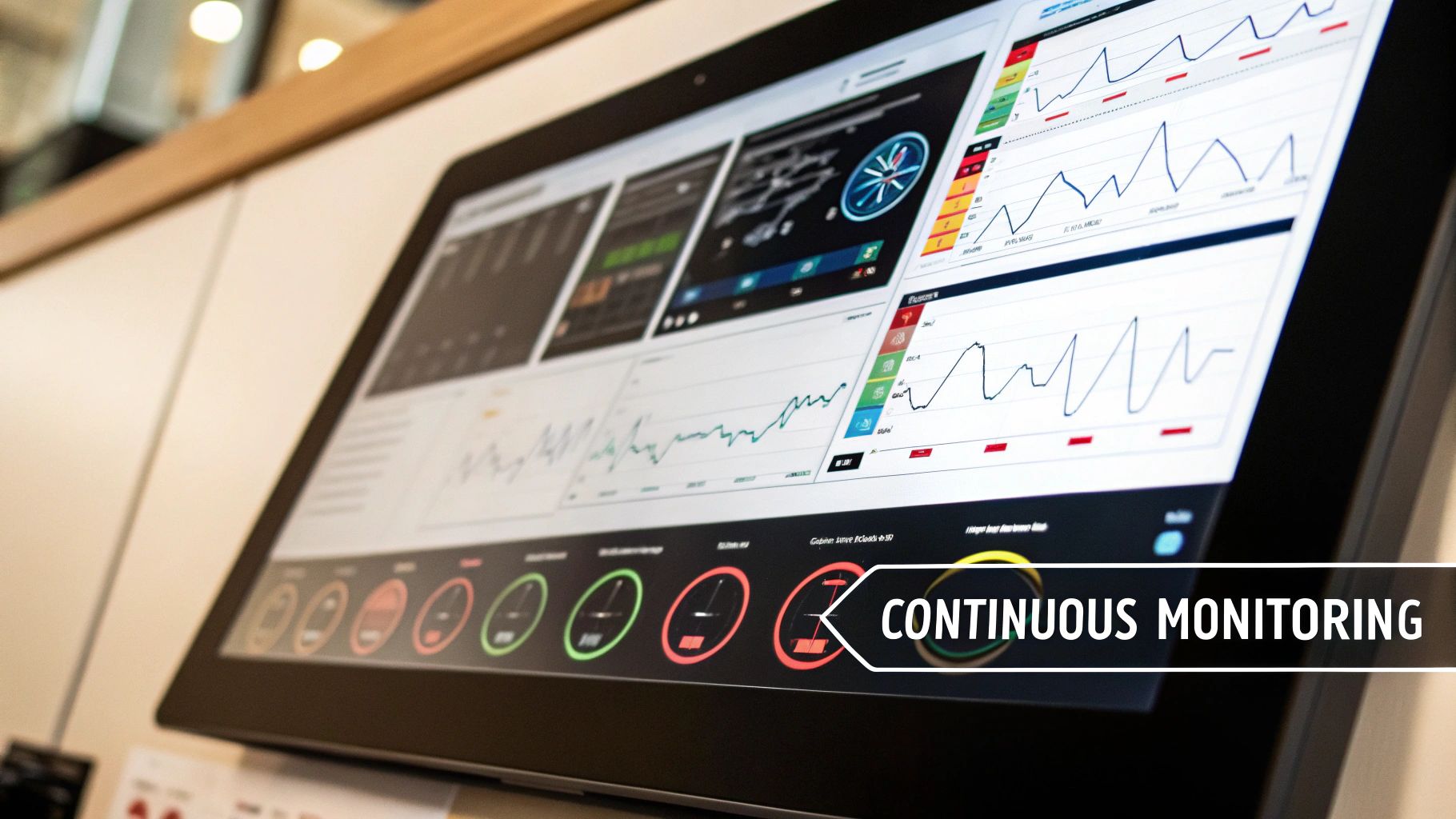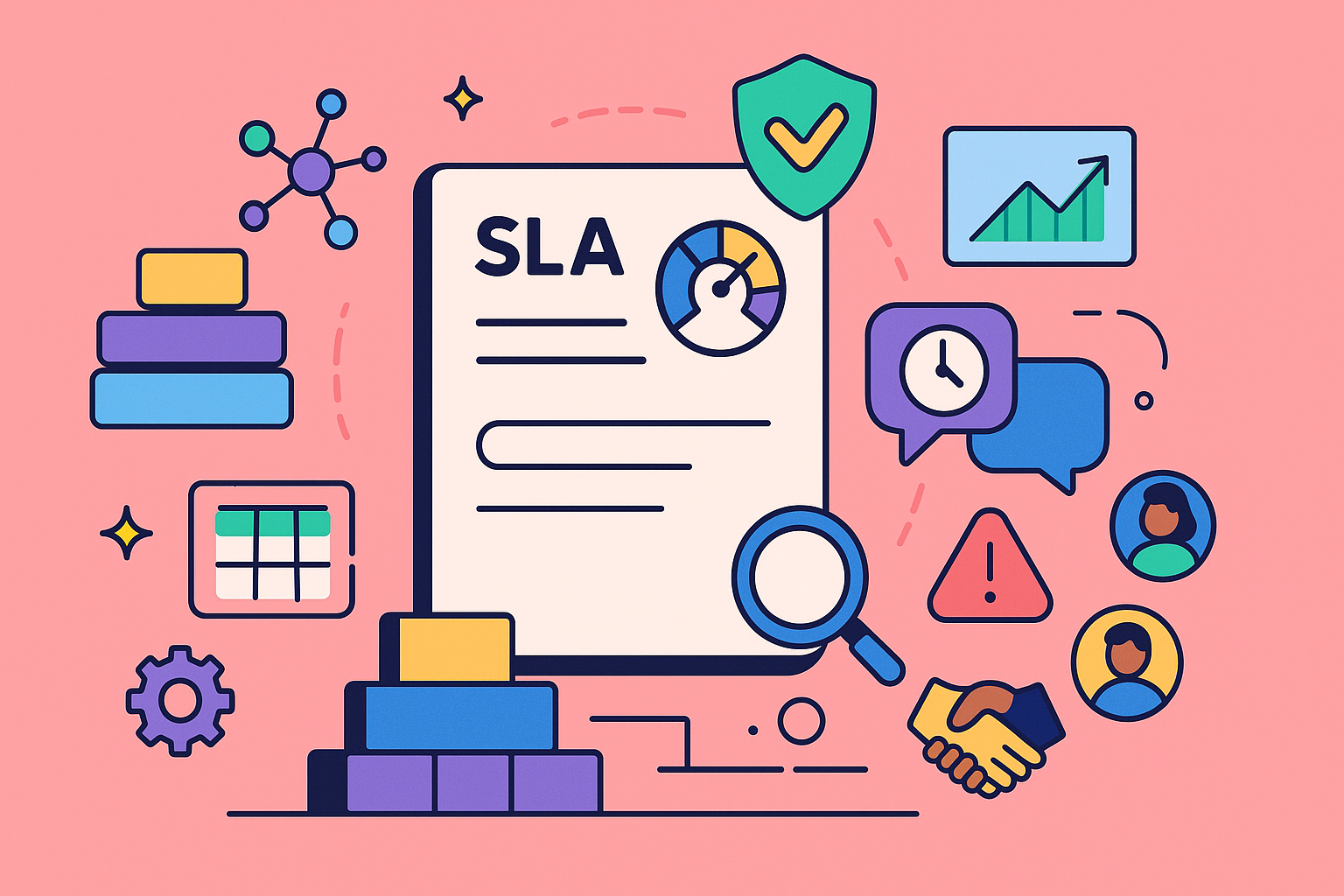In today’s service-driven economy, a Service Level Agreement (SLA) is more than just a contractual document; it’s the backbone of customer trust and operational excellence. Yet, many organizations still rely on outdated, generic SLAs that fail to capture true business value or drive meaningful performance improvements. These documents often focus on simple uptime metrics while ignoring what truly matters: end-user experience, business impact, and proactive service management. A truly effective SLA requires a solid internal foundation. Before diving deep into best practices, it’s essential to understand the core distinctions between Operational Level Agreements (OLAs) and Service Level Agreements (SLAs), as clarity here forms the bedrock of effective service delivery.
This guide moves beyond the basics, offering a comprehensive roundup of actionable service level agreement best practices designed for modern IT and service desk teams. We’ll explore how to craft, measure, and evolve your SLAs to not only meet contractual obligations but to transform them into powerful tools for strategic alignment and continuous improvement. From defining business-centric KPIs and establishing clear incident management protocols to implementing robust penalty systems, these eight practices will help you build a framework that delivers measurable results and strengthens stakeholder relationships.
1. Define Clear, Measurable Metrics and KPIs
The foundation of any effective service level agreement is a set of clear, quantifiable metrics and key performance indicators (KPIs). Without specific, measurable targets, an SLA is merely a collection of ambiguous promises, making it impossible to objectively assess performance or enforce accountability. This practice ensures both the service provider and the client share a precise understanding of what success looks like, transforming abstract goals into concrete, data-driven benchmarks.

This approach moves beyond vague commitments like “high availability” to specific guarantees. For instance, Amazon Web Services (AWS) guarantees a 99.99% uptime for specific EC2 instances, detailing exactly how that percentage is calculated monthly. Similarly, Salesforce defines support response times by priority level, promising a two-hour response for critical issues and an eight-hour response for high-priority cases. These examples show how precise metrics create clear expectations.
Why It’s a Top Practice
Establishing these metrics is a critical first step because it eliminates subjectivity. When issues arise, there is no room for debate about whether service levels were met. The data provides a definitive answer, fostering a relationship built on transparency and trust rather than conflict and interpretation. This clarity is essential for managing expectations and maintaining a healthy partnership.
Actionable Implementation Tips
To effectively integrate this into your service level agreement best practices, follow these steps:
- Apply the SMART Framework: Ensure every metric is Specific, Measurable, Achievable, Relevant, and Time-bound. Instead of “fast ticket resolution,” use “Resolve 90% of P1 tickets within 4 hours.”
- Establish Realistic Baselines: Use historical performance data to set achievable targets. Setting an unattainable goal from the start undermines the SLA’s credibility and demotivates your team.
- Cover Key Service Areas: Include a mix of metrics to provide a holistic view of performance.
- Availability: Uptime percentages, system accessibility.
- Performance: Application response time, data throughput.
- Support Responsiveness: First response time, resolution time.
- Define Measurement Protocol: Clearly state how, when, and by what tool each metric will be measured. This prevents disputes over data collection and reporting methodologies.
2. Implement Tiered Service Levels with Escalation Procedures
A one-size-fits-all approach to service delivery is inefficient and fails to address the varying urgency of different issues. A core component of modern service level agreement best practices is implementing a tiered service structure. This involves creating multiple service levels based on factors like issue criticality, business impact, or customer segment, each with its own set of response and resolution targets. This ensures that resources are allocated effectively, with the most critical problems receiving the fastest attention.

This model is common in mature IT service management. For example, the ITIL framework defines incident priority levels, from P1 (a major system outage) requiring a one-hour response to P4 (a minor user query) allowing a 48-hour response. Similarly, platforms like Zendesk and ServiceNow enable priority-based ticket routing, automatically assigning issues to the correct queue and triggering escalation workflows if an SLA is at risk of being breached. This structured approach provides a clear, predictable problem-resolution process for everyone involved.
Why It’s a Top Practice
Tiered service levels prevent minor requests from diverting attention from critical incidents, protecting business continuity. By pairing tiers with a formal escalation procedure, you create a safety net that ensures no issue is forgotten. If a P1 ticket is not addressed within its initial timeframe, it automatically moves up the chain of command, guaranteeing visibility and accountability until it is resolved. This proactive system minimizes downtime and maintains customer satisfaction.
Actionable Implementation Tips
To effectively implement tiered levels and escalations in your service level agreement:
- Clearly Define Priority Levels: Document exactly what constitutes each tier (e.g., P1, P2, P3) with concrete examples. A “critical” issue might be defined as “a full system outage affecting all users,” while a “low” priority issue could be “a cosmetic UI bug with a known workaround.”
- Automate Escalation Workflows: Use your service desk software to build automated rules that escalate tickets if they remain unresolved past a certain percentage of their SLA time. This removes manual oversight and prevents issues from falling through the cracks. For guidance, you can build a structured escalation matrix template to outline these paths.
- Train All Stakeholders: Ensure both the service team and the clients understand how to classify ticket priority correctly. Misclassification is a common point of failure, leading to frustration and inefficient resource use.
- Review Escalation Patterns: Regularly analyze which issues are most frequently escalated. This data can reveal underlying problems, such as inadequate training, insufficient staffing for certain issue types, or unrealistic SLA targets that need adjustment.
3. Establish Comprehensive Penalty and Reward Systems
A service level agreement without consequences is just a suggestion. To give an SLA real authority, it must include a system of penalties for non-compliance and, equally important, rewards for exceptional performance. This balanced approach moves beyond simple enforcement, creating a powerful incentive structure that aligns the service provider’s goals directly with the client’s success. It ensures accountability for underperformance while actively motivating the provider to strive for excellence.

This practice is standard among major cloud providers. For instance, Amazon Web Services (AWS) issues a 10% service credit if monthly uptime for certain services drops below 99.99%. Google Cloud Platform takes a steeper approach, offering a 50% service credit if monthly uptime falls below 95%. These clear financial repercussions, known as “service credits,” provide tangible remediation for service failures, while many managed service providers offer performance bonuses for consistently exceeding availability targets.
Why It’s a Top Practice
Implementing a penalty and reward system transforms the SLA from a passive document into an active management tool. Penalties provide a clear, contractual remedy for service disruptions, protecting the client’s investment. Conversely, rewards foster a positive, collaborative partnership by acknowledging and incentivizing superior service, encouraging proactive problem-solving and continuous improvement rather than just meeting the minimum standard.
Actionable Implementation Tips
To build a fair and effective incentive structure into your service level agreement best practices, follow these guidelines:
- Balance Penalties with Rewards: A purely punitive system can create an adversarial relationship. Include incentives, such as performance bonuses or contract extensions, for exceeding targets to foster a positive partnership.
- Keep Calculations Simple: Ensure the formula for calculating penalties (e.g., service credits) is straightforward and transparent. Both parties should be able to calculate it easily to avoid disputes.
- Cap Total Penalties: Include a “liability cap” that limits the total amount of penalties a provider can incur in a given period. This protects the provider from excessive financial risk, making the SLA more agreeable.
- Define a Clear “Earn Back” Clause: Consider adding a provision that allows a provider to “earn back” a penalty by demonstrating a sustained period of high performance after a failure. This incentivizes a quick recovery and long-term stability.
4. Define Detailed Scope and Exclusions
A common source of conflict in service agreements stems from misunderstandings about what is covered. Clearly articulating the precise scope of services, components, and scenarios included in the SLA, while also explicitly stating what is excluded, is a critical practice. This prevents scope creep, manages client expectations, and eliminates ambiguity regarding service boundaries and responsibilities.

This practice draws a firm line around what the provider is accountable for. For instance, a cloud infrastructure provider like Microsoft Azure will guarantee the availability of its virtual machines but explicitly excludes issues arising from the customer’s own application code or misconfigurations. Similarly, a software vendor’s SLA might cover platform uptime but exclude performance problems caused by third-party integrations not managed by them. These clear distinctions are fundamental to a functional agreement.
Why It’s a Top Practice
Defining a detailed scope is essential because it sets clear boundaries for accountability. When a service disruption occurs, a well-defined scope allows both parties to quickly determine if the issue falls under the SLA’s purview, avoiding lengthy disputes. This clarity helps build trust and ensures that the provider is not held responsible for factors outside its control, making for a fair and sustainable partnership.
Actionable Implementation Tips
To effectively implement this into your service level agreement best practices, follow these steps:
- Be Explicit with Inclusions and Exclusions: Create two distinct lists. One details every service, function, and component covered. The other specifies what is not covered, such as end-user hardware, third-party software, or issues resulting from client-side errors.
- Use Clear, Simple Language: Avoid overly technical jargon that business stakeholders might not understand. The goal is mutual comprehension, so write the scope definitions in plain terms.
- Illustrate Service Boundaries: Where possible, include diagrams or flowcharts to visually represent the service ecosystem. This can help clarify complex dependencies and pinpoint exact areas of responsibility.
- Regularly Review and Update: Services evolve, and so should your SLA’s scope. Schedule periodic reviews, perhaps quarterly or annually, to ensure the defined boundaries still accurately reflect the current service offering and client environment.
5. Implement Continuous Monitoring and Reporting
A service level agreement is only as good as the systems in place to track it. Implementing continuous monitoring and regular reporting transforms an SLA from a static document into a living, breathing component of your service delivery. This practice involves using automated tools to track performance against defined metrics in real-time, providing both the service provider and the client with a transparent, up-to-the-minute view of how services are performing. This constant visibility enables proactive problem-solving and reinforces accountability.
Leading technology platforms exemplify this practice. For instance, Datadog offers comprehensive infrastructure monitoring with customizable dashboards and automated alerts that can be tied directly to SLA thresholds. Similarly, New Relic provides deep application performance monitoring (APM) with built-in SLA reporting features, allowing teams to see exactly how application response times impact user experience and service commitments. These tools make performance data accessible and actionable.
Why It’s a Top Practice
Continuous monitoring is a cornerstone of modern service level agreement best practices because it shifts teams from a reactive to a proactive stance. Instead of waiting for a customer to report an outage, monitoring systems can detect anomalies and trigger alerts before they escalate into major incidents. This transparency builds immense trust, as clients can see for themselves that you are actively managing their services and holding yourself accountable to the agreed-upon standards.
Actionable Implementation Tips
To effectively integrate this into your service level agreement best practices, follow these steps:
- Automate Data Collection and Reporting: Use specialized tools to automatically track KPIs and generate reports. This reduces manual overhead, eliminates human error, and ensures data is always current. To implement effective continuous monitoring for your SLAs, leveraging modern integration methods is crucial; a good Webhook Integration Guide can help you connect disparate monitoring tools and notification systems seamlessly.
- Provide Client-Facing Dashboards: Offer clients read-only access to a real-time performance dashboard. This radical transparency demonstrates confidence and empowers clients with the same data your team uses, fostering a stronger partnership.
- Focus on Actionable Metrics: Your reports should highlight metrics that drive decisions. Instead of just showing “uptime was 99.95%,” include data on the business impact of the 0.05% downtime. To create clear and impactful reports, you might want to learn more about how to structure a project status report.
- Integrate Technical and Business Metrics: Monitor not only technical performance like server CPU usage but also how that performance affects business outcomes, such as transaction completion rates or user satisfaction scores.
6. Regular Review and Continuous Improvement
A service level agreement is not a static document to be filed away and forgotten. One of the most critical service level agreement best practices is to establish a cycle of regular review and continuous improvement. This practice ensures the SLA remains a living, relevant guide that adapts to changing business needs, technological advancements, and evolving customer expectations. By treating the SLA as a dynamic framework, organizations can proactively optimize service delivery instead of reactively addressing failures.
This iterative approach transforms the SLA from a mere contractual obligation into a strategic tool for service excellence. For instance, major cloud providers like Microsoft Azure conduct periodic reviews with their enterprise clients to ensure SLAs for services like Virtual Machines or Azure DevOps still align with their operational goals. Similarly, managed service providers (MSPs) often hold quarterly business reviews (QBRs) specifically to analyze performance data against the SLA and identify opportunities for improvement.
Why It’s a Top Practice
Implementing a formal review process prevents “SLA drift,” where the agreement’s terms become outdated and misaligned with the actual service environment. It fosters a culture of continuous improvement, where performance data is used not just for accountability but for learning and enhancement. This proactive stance helps identify potential issues before they escalate, strengthens the client-provider relationship through collaborative discussion, and ensures the service continues to deliver maximum business value.
Actionable Implementation Tips
To effectively integrate this into your service level agreement best practices, follow these steps:
- Schedule Formal Reviews: Set a consistent cadence for reviews, such as quarterly or bi-annually. Don’t wait for a major incident to scrutinize the SLA; proactive, scheduled check-ins are far more effective.
- Involve All Stakeholders: Ensure both technical teams and business stakeholders from the client and provider sides are present. This provides a holistic perspective, combining quantitative performance data with qualitative business impact feedback.
- Analyze Performance and Trends: Go beyond simply checking if metrics were met. Analyze trends over time to spot patterns, identify recurring issues, and forecast future needs. For a deeper dive into this, you can learn more about continuous improvement metrics on resolution.de.
- Document and Act on Findings: Meticulously document all discussions, agreed-upon changes, and action items from the review meeting. Assign ownership and deadlines to ensure that proposed improvements are implemented and tracked for effectiveness in the next cycle.
7. Align SLAs with Business Objectives and User Experience
A technically perfect SLA that fails to support business goals is ultimately ineffective. This practice involves shifting the focus from purely technical, system-centric metrics like server uptime to performance indicators that directly reflect business outcomes and end-user satisfaction. It ensures that service delivery is not just about keeping the lights on but about empowering the business to succeed and providing a seamless customer experience.
This approach translates IT performance into business value. For instance, an e-commerce platform’s SLA might prioritize transaction completion rates during a Black Friday sale over general server uptime. Similarly, a financial services provider would measure end-to-end trade processing times, as this directly impacts revenue, rather than just isolated system response times. These examples demonstrate how aligning SLAs with business objectives creates meaningful, context-aware targets.
Why It’s a Top Practice
Focusing on business outcomes makes the IT or service team an integral strategic partner rather than just a cost center. It ensures that resources and efforts are concentrated on what truly matters to stakeholders and customers, fostering a culture of value-driven service delivery. This alignment is a cornerstone of modern service level agreement best practices because it validates the real-world impact of service performance.
Actionable Implementation Tips
To effectively implement this practice and create a more strategic SLA, follow these guidelines:
- Map IT Metrics to Business Outcomes: Work with business leaders to identify critical processes. Instead of just “database availability,” measure “customer record retrieval time” or “inventory lookup success rate.”
- Incorporate User Experience Metrics: Include targets for Customer Satisfaction (CSAT) or Net Promoter Score (NPS) scores related to service interactions. Consider using synthetic monitoring to test critical user workflows from an end-user perspective. Learn more about mapping the customer journey on resolution.de.
- Define Business-Critical Timeframes: Apply stricter service levels during peak usage periods. A retail platform needs higher performance during holiday shopping seasons, while a payroll system is most critical at the end of the month.
- Regularly Validate Correlation: Periodically analyze whether your SLA metrics still correlate with business success and user satisfaction. Business priorities change, and your SLA must evolve with them.
8. Establish Clear Communication and Incident Management Protocols
Beyond performance metrics, a robust SLA must define how and when information is shared. Establishing comprehensive communication and incident management protocols ensures that all stakeholders receive timely, accurate, and relevant updates during both routine operations and crisis situations. This practice is crucial for building trust, managing expectations, and enabling effective collaboration when it matters most.
This practice formalizes the flow of information, preventing confusion and speculation during a service disruption. For example, Atlassian uses public status pages to provide real-time incident updates, followed by detailed postmortem reports. Similarly, GitHub’s incident communications detail the impact, a clear timeline, and resolution steps, keeping users fully informed. These proactive approaches demonstrate transparency and respect for the client’s operational needs.
Why It’s a Top Practice
Well-defined communication protocols are a cornerstone of effective service level agreement best practices because they manage the human element of service delivery. During a high-stakes incident, silence from a provider breeds frustration and erodes confidence. A clear plan ensures that even if a fix isn’t immediate, the client feels informed and respected, which is vital for a healthy, long-term partnership.
Actionable Implementation Tips
To effectively integrate this into your service level agreement best practices, follow these steps:
- Establish Communication Triggers: Define specific triggers for communication based on incident severity or duration. For instance, a P1 critical incident might trigger an initial notification within 15 minutes, with updates every 30 minutes thereafter.
- Use Multiple Channels: Specify primary and secondary communication channels (e.g., email, status page, SMS alerts) to ensure important messages are received.
- Provide Regular, Proactive Updates: Commit to providing updates at scheduled intervals, even if there is no new information. A simple “We are still investigating the root cause and will update you in 20 minutes” is better than silence. This aligns with client communication best practices by keeping stakeholders engaged.
- Define Roles and Responsibilities: Clearly outline who is responsible for communicating with whom. This avoids confusion and ensures a single source of truth during an incident. For more on structuring these roles, explore these internal communication best practices.
Best Practices Comparison of 8 SLA Elements
| Practice | Implementation Complexity 🔄 | Resource Requirements ⚡ | Expected Outcomes 📊 | Ideal Use Cases 💡 | Key Advantages ⭐ |
|---|---|---|---|---|---|
| Define Clear, Measurable Metrics and KPIs | Medium – requires baseline setup and tool investment | Moderate – monitoring tools and analytics | Objective performance evaluation and accountability | SLA performance tracking, legal clarity | Eliminates ambiguity; enables continuous improvement |
| Implement Tiered Service Levels with Escalation Procedures | High – multiple tiers & escalation paths complexity | Moderate to High – training and process adherence | Faster response for critical issues; optimized resource use | Incident management in IT support | Ensures critical issues prioritized; clear accountability |
| Establish Comprehensive Penalty and Reward Systems | Medium-High – complex calculations and admin | Moderate – financial and administrative overhead | Motivated performance; automatic compensation | Contracts requiring strong incentives | Provides financial motivation; reduces disputes |
| Define Detailed Scope and Exclusions | Medium – requires extensive documentation | Low to Moderate – documentation efforts | Clear service boundaries; prevents scope creep | Contract clarity; expectation management | Prevents disputes; enables accurate planning |
| Implement Continuous Monitoring and Reporting | High – requires investment in real-time systems | High – infrastructure and analysis tools | Proactive issue detection; transparency and trust | Real-time SLA adherence monitoring | Enables prevention; supports data-driven decisions |
| Regular Review and Continuous Improvement | Medium – ongoing process management | Moderate – stakeholder time and resources | SLA relevance maintained; continuous service optimization | Long-term SLA management | Drives improvement; aligns with evolving needs |
| Align SLAs with Business Objectives and User Experience | High – complex metric design and tracking | Moderate to High – tools and surveys | Meaningful business-focused metrics; enhanced user satisfaction | Customer-centric SLA design | Improves satisfaction; links SLAs to business value |
| Establish Clear Communication and Incident Management Protocols | Medium – process and channel setup | Moderate – communication tools and templates | Builds trust; faster incident resolution | Incident handling and status communication | Enhances transparency; reduces customer anxiety |
Turning SLA Best Practices into Your Competitive Advantage
The journey through service level agreement best practices reveals a powerful truth: SLAs are far more than contractual obligations or simple performance metrics. When meticulously crafted and dynamically managed, they evolve into strategic assets that drive service excellence, foster trust, and create a significant competitive advantage. Moving beyond static documents to living frameworks is the cornerstone of modern service delivery.
We’ve explored a comprehensive roadmap, from the foundational necessity of defining clear, measurable metrics to the strategic importance of aligning SLAs with core business objectives. Each practice, whether it’s implementing tiered service levels, establishing robust penalty and reward systems, or defining a precise scope with clear exclusions, contributes to a more resilient and responsive service operation. The real power, however, is unlocked when these elements work in concert, creating a holistic system that is greater than the sum of its parts.
From Theory to Action: Your Next Steps
Adopting these principles is not an all-or-nothing initiative. The most effective approach is iterative and focused. Start by auditing your current SLA framework against the best practices discussed.
- Immediate Action: Identify the one or two areas with the most significant gaps. Is your reporting manual and infrequent? Begin by implementing continuous monitoring and automated reporting. Are your incident management protocols vague? Work with stakeholders to establish clear communication and escalation pathways.
- Strategic Alignment: Re-evaluate your key performance indicators (KPIs). Do they genuinely reflect the user experience and contribute to broader business goals? If not, schedule workshops with business leaders to redefine what success truly looks like.
- Cultural Integration: Foster a culture of continuous improvement. The practice of regularly reviewing and refining your SLAs should not be an annual chore but an ongoing, collaborative process. This ensures your service commitments adapt to changing business needs, new technologies, and evolving customer expectations.
Ultimately, mastering these service level agreement best practices is about setting a new standard. It’s about transforming your service desk or managed service offering from a reactive cost center into a proactive, value-generating partner. For global teams, this includes overcoming communication hurdles that can derail even the best-laid plans. Ensuring that every customer, regardless of their language, receives timely and effective support is paramount. Tools that bridge these language gaps are no longer a luxury; they are essential for upholding SLA commitments in a globalized marketplace.
By implementing these strategies, you are not just promising reliability; you are engineering it into the DNA of your operations. You build stronger client relationships, enhance operational efficiency, and deliver a consistently superior experience that distinguishes your brand and turns satisfied customers into loyal advocates.
Ready to eliminate language barriers and ensure your global support team consistently meets its SLA targets? Discover how resolution Reichert Network Solutions GmbH can help you by exploring our Issue Translation for Jira Service Management. Automate ticket translation to empower your agents, reduce response times, and deliver exceptional service to every customer, anywhere in the world.
